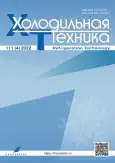Target temperature of local cryotherapy
- Authors: Saakyan N.Y.1, Pushkarev A.V.1
-
Affiliations:
- Bauman Moscow State Technical University
- Issue: Vol 111, No 4 (2022)
- Pages: 289-295
- Section: Short Communications
- URL: https://freezetech.ru/0023-124X/article/view/114722
- DOI: https://doi.org/10.17816/RF114722
- ID: 114722
Cite item
Abstract
BACKGROUND: Local cryotherapy (LC) is a promising method for treating various diseases, achieving the effects of anesthesia, and a reduction of inflammation. From a physical viewpoint, the main factor of efficiency is achieving the target temperature on an impact area surface. At the same time, during the procedure, the surface temperature of the tissue should not fall below the minimum permissible temperature for safety.
AIMS: Identification of the ranges of temperature targets and temperature limits in terms of safety parameters based on the results of a literature analysis, performing experiments with the use of an ice bag for cooling the biotissue phantom, and determining the most appropriate impact modes.
MATERIALS AND METHODS: A series of experiments was performed on the developed stand to compare two contact cooling modes of LC, depending on the working substance used (sodium chloride solution or a mixture of ice and water). The comparison was conducted according to the following parameters: the time to reach the target temperature on the surface and the temperature at the depth of the model medium. The temperature was measured using resistance thermometers (Pt100).
RESULTS: When cooled with a sodium chloride solution, the surface temperature of the model medium dropped to 10 °C in 6 min of exposure and reached its minimum value of 6.2 °C after 17 min. In the case of using a mixture of water and ice, a minimum temperature of 12.5 °C was reached in 58 min. In both cases, the minimum temperature at a depth of 8 mm was approximately 16 °C, reached in 20 min and 60 min with a solution of sodium chloride and a mixture of water and ice, respectively.
CONCLUSIONS: On the basis of the experiments, the most suitable contact cooling mode with the use of an ice bag was determined—using sodium chloride as the working substance at an initial temperature of −18.4 °C, with a possible impact time of 6–25 min.
Keywords
Full Text
About the authors
Natalia Yu. Saakyan
Bauman Moscow State Technical University
Email: natali.saakyan@mail.ru
ORCID iD: 0000-0001-6799-5450
SPIN-code: 4390-3138
Student
Russian Federation, MoscowAleksandr V. Pushkarev
Bauman Moscow State Technical University
Author for correspondence.
Email: pushkarev@bmstu.ru
ORCID iD: 0000-0002-1737-7838
SPIN-code: 5796-8324
leading engineer, Cand. Sci. (Tech.)
Russian Federation, MoscowReferences
- Cieza A, Causey K, Kamenov K, et al. Global estimates of the need for rehabilitation based on the Global Burden of Disease study 2019: a systematic analysis for the Global Burden of Disease Study 2019. The Lancet. 2021;396(10267):2006–2017. doi: 10.1016/S0140-6736(20)32340-0
- Harris ED Jr, McCroskery PA. The influence of temperature and fibril stability on degradation of cartilage collagen by rheumatoid synovial collagenase. The New England journal of medicine. 1974;290(1):1–6. doi: 10.1056/NEJM197401032900101
- Portnov VV. Local air cryotherapy in clinical practice. Kremlin Medicine Journal. 2017;4(2):157-164. (In Russ.)
- Algafly AA, George KP. The effect of cryotherapy on nerve conduction velocity, pain threshold and pain tolerance. British journal of sports medicine. 2007;41(6):365–369. doi: 10.1136/bjsm.2006.031237
- Bugaj R. The Cooling, Analgesic, and Rewarming Effects of Ice Massage on Localized Skin. Physical Therapy. 1975;55(1):11–19. doi: 10.1093/ptj/55.1.11
- Laktašić Žerjavić N, Hrkić E, Žagar I, et al. Local Cryotherapy, Comparison of Cold Air and Ice Massage on Pain and Handgrip Strength in Patients with Rheumatoid Arthritis. Psychiatria Danubina. 2021;33(4):757-761.
- McMeeken J, Lewis MM, Cocks S. Effects of cooling with simulated ice on skin temperature and nerve conduction velocity. The Australian journal of physiotherapy. 1984;30(4):111–114. doi: 10.1016/S0004-9514(14)60682-6
- Weeks V, Travell J. How to Give Painless Injections. In: AMA Scientific Exhibits Volume. New York: Grune and Stratton Inc; 1957. P. 318–322.
- Castro PATS, Machanocker DH, Luna GF, et al. Clinical-Like Cryotherapy in Acute Knee Arthritis Protects Neuromuscular Junctions of Quadriceps and Reduces Joint Inflammation in Mice. BioMed Research International. 2022;2022:7442289. doi: 10.1155/2022/7442289
- Douzi W, Guillot X, Bon D, et al. 1H-NMR-Based Analysis for Exploring Knee Synovial Fluid Metabolite Changes after Local Cryotherapy in Knee Arthritis Patients. Metabolites. 2020;10(11):460. doi: 10.3390/metabo10110460
- Guillot X, Tordi N, Laheurte C, et al. Local ice cryotherapy decreases synovial interleukin 6, interleukin 1β, vascular endothelial growth factor, prostaglandin-E2, and nuclear factor kappa B p65 in human knee arthritis: a controlled study. Arthritis research & therapy. 2019;21(1):180. doi: 10.1186/s13075-019-1965-0
- Sasaki R, Sakamoto J, Kondo Y, et al. Effects of Cryotherapy Applied at Different Temperatures on Inflammatory Pain During the Acute Phase of Arthritis in Rats. Physical therapy. 2021;101(2):pzaa211. doi: 10.1093/ptj/pzaa211
- Fuhrman G.J, Fuhrman F.A. Oxygen consumption of animals and tissues as a function of temperature. The Journal of general physiology. 1959;42(4):715–722. doi: 10.1085/jgp.42.4.715
- Mourot L, Cluzeau C, Regnard J. Hyperbaric gaseous cryotherapy: effects on skin temperature and systemic vasoconstriction. Archives of physical medicine and rehabilitation. 2007;88(10):1339–1343. doi: 10.1016/j.apmr.2007.06.771
- Radecka A, Pluta W, Lubkowska A. Assessment of the Dynamics of Temperature Changes in the Knee Joint Area in Response to Selected Cooling Agents in Thermographic Tests. International journal of environmental research and public health. 2021;18(10):5326. doi: 10.3390/ijerph18105326
- Garcia C, Karri J, Zacharias NA, Abd-Elsayed A. Use of Cryotherapy for Managing Chronic Pain: An Evidence-Based Narrative. Pain and therapy. 2021;10(1):81–100. doi: 10.1007/s40122-020-00225-w
- Bogolubov VM, Ponomarenko GY. General Physiotherapy. 3th ed. Moscow: Medicine; 1999. (In Russ).
- Sapega AA, Heppenstall RB, Sokolow DP, et al. The bioenergetics of preservation of limbs before replantation. The rationale for intermediate hypothermia. The Journal of bone and joint surgery. American volume. 1988;70(10):1500–1513.
- Agafonkina IV, Belozerov AG, Berezovsky YM, et al. Thermal Properties of Biological Tissue Gel-Phantoms in a Wide Low-Temperature Range. Journal of Engineering Physics and Thermophysics. 2021;94(3):790–803. doi: 10.1007/s10891-021-02356-z
- Agafonkina IV, Belozerov AG, Vasilyev AO, et al. Thermal Properties of Human Soft Tissue and Its Equivalents in a Wide Low-Temperature Range. Journal of Engineering Physics and Thermophysics. 2021;94(1):233–246. doi: 10.1007/s10891-021-02292-y
Supplementary files









